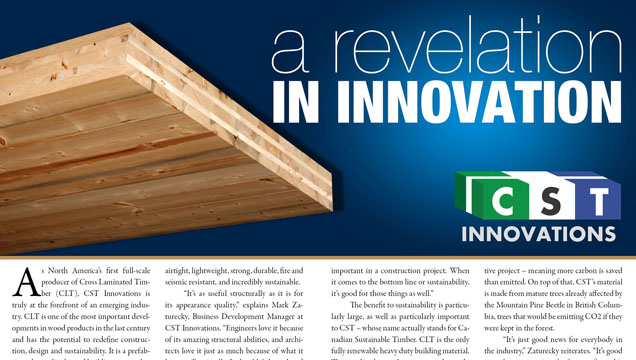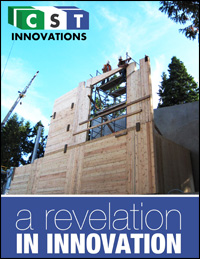

A revelation in innovation
As North America’s first full-scale producer of Cross Laminated Timber (CLT), CST Innovations is truly at the forefront of an emerging industry. CLT is one of the most important developments in wood products in the last century and has the potential to redefine construction, design and sustainability. It is a prefabricated, panelised wood building system that rivals reinforced concrete and has a veritable laundry list of benefits – it is quick to install, airtight, lightweight, strong, durable, fire and seismic resistant, and incredibly sustainable.
“It’s as useful structurally as it is for its appearance quality,†explains Mark Zaturecky, Business Development Manager at CST Innovations. “Engineers love it because of its amazing structural abilities, and architects love it just as much because of what it has to offer visually. It shouldn’t be reduced into just a product that is good at one or two things. It really is good at everything that is important in a construction project. When it comes to the bottom line or sustainability, it’s good for those things as well.â€
The benefit to sustainability is particularly large, as well as particularly important to CST – whose name actually stands for Canadian Sustainable Timber. CLT is the only fully renewable heavy duty building material. The wood in the panels sequester carbon, taking it out of the carbon cycle. In fact, building a home with CLT can be a carbon positive project – meaning more carbon is saved than emitted. On top of that, CST’s material is made from mature trees already affected by the Mountain Pine Beetle in British Columbia, trees that would be emitting CO2 if they were kept in the forest.
“It’s just good news for everybody in the industry,†Zaturecky reiterates. “It’s good news for construction, for forestry, for architecture, and engineering, and real estate as well.â€
A long process
“We were originally the solid wood research division for Canfor, one of the largest wood products companies in North America,†recounts Zaturecky. “We did all their research and development when it comes to solid wood products for about 15 years and became experts in gluing solid wood.†In 2007, CST Innovations divested and began undertaking their own research and development projects on a contract by contract basis. “That led us to discover CLT and the amazing promise and potential of that product and building system.â€
While cross laminated timber is not new itself – it has been used extensively in Europe for 20 years – it is new to North America, so achieving mainstream acceptance for the product may take some time. “It’s a long process,†Zaturecky says. “Getting any sort of construction product to mainstream is always going to take very long, and we have to be very patient. But there have been incredible leaps and bounds made in the volume of cross laminated timber used in North America, especially on the west coast in Vancouver and British Columbia – which is a hub of CLT interest and usage.â€
So far, CLT has been mainly used in a handful of government aided projects that have served as demonstrations. Those projects have helped integrate it into the construction industry, and Zaturecky says he is now seeing ambitious private projects starting up as well.
CST innovations itself has been involved with the University of British Columbia’s Bio-energy Research and Demonstration project – a 15,200 square foot facility that will use 34,000 square feet of CLT panels manufactured and supplied by CST. That facility, when it opens this spring, will be the first biomass-fuelled heat-and-power generation system of its kind in the world and will generate 15 per cent of campus electricity from urban wood waste. It is the first public CLT project approved in Canada, the largest CLT building in North America, and the culmination of years of dedicated preparation and planning.
“It’s going very well, and is approaching completion,†says Zaturecky of the project. “All the panels have been delivered; it should be online in just a few months. The doors should be open and it should be producing bio-energy for the University of British Columbia very soon.â€
As far as other types of projects that CLT could be utilised in, Zaturecky says there are not many restrictions. “The potential applications of cross laminated timber are virtually unlimited. You can build multi storey residential from six storeys up to 30 storeys, theoretically. You can build kindergartens as well as full universities. You can build light industrial, offices, and warehouse buildings as well. It’s not just a niche product – it can be used for anything, rural or urban.â€
Since 2007, CST Innovations has been focused on researching and developing high appearance quality (important) CLT and all the services that must be available for it to be effective. Due to this diligence and depth of expertise, CST is able to offer guidance from the earliest stages of a CLT project all the way to the finishing touches. Through their partners, CST is able to offer a full complement of installation and engineering services as well.
One of their close partners is Read Jones Christofferson Consulting Engineers (RJC), one of Canada’s largest consulting engineering firms. RJC recognises the opportunity CLT presents for both Canada and the United States, and together with CST, they have designed structures and solutions that utilise the product since 2009.  “We have a very close relationship with RJC,†says Zaturecky. “We also have a close relationship with installers, and we’ve worked closely with architects as well to make sure their visions are implemented.â€
Achieving the ideal
Zaturecky sees huge growth in the future for CST, but says that while he expects it will happen fast, it will not happen overnight. “There’s a huge amount of inertia when you’re dealing with construction industries and government,†he says. “It’s a very slow but ongoing process of educating the users, and making sure they’re using it properly, making sure the codes are accepting of cross laminated timber, and making sure it is used in its full potential and capacity.â€
“However,†he continues, “Anytime CLT has gotten hold of a new market, the growth has been exponential. We’ve seen it when it originated in Central Europe 20 years ago and it spread to Scandinavia, and just half a decade ago it spread to the United Kingdom and spread like wildfire there. Even in mature markets, the volume has grown by double digits year on year.â€
As the market expands, CST Innovations will expand their services and capabilities with it. “We want a client to be able to come to us with a vision,†Zaturecky explains. “We want to take all the guesswork and all the fuss out of it, so we can take their vision and actually just do it all ourselves exactly to their specifications – making sure that we can handle all their biggest concerns, and all the concerns they have but haven’t realized yet. A fully integrated solution.â€
With the domestic advent of CLT, Zaturecky has high hopes and expectations for CST Innovations. Even more importantly, however, he is excited for the whole forestry industry. “Over the last couple of decades, the philosophy behind a vibrant forestry economy has been innovation,†he says. “That’s not just limited to forestry either, that should be the philosophy behind every industry. Innovation has always been the ideal, but it’s very difficult to actually find a product with the proper groundbreaking potential.â€
According to Zaturecky, that groundbreaking discovery is exactly what the industry has found with CLT. “It’s one of the greatest revolutions in wood technology in the last hundred years,†he says. “Now we’re actually seeing the ideal by which we’ve lived by for the last 20 years – which is innovation – actually take place in front of us.â€
For more information of CST Innovations and the benefits of cross laminated timber, visit their website at http://www.cstinnovations.ca/








